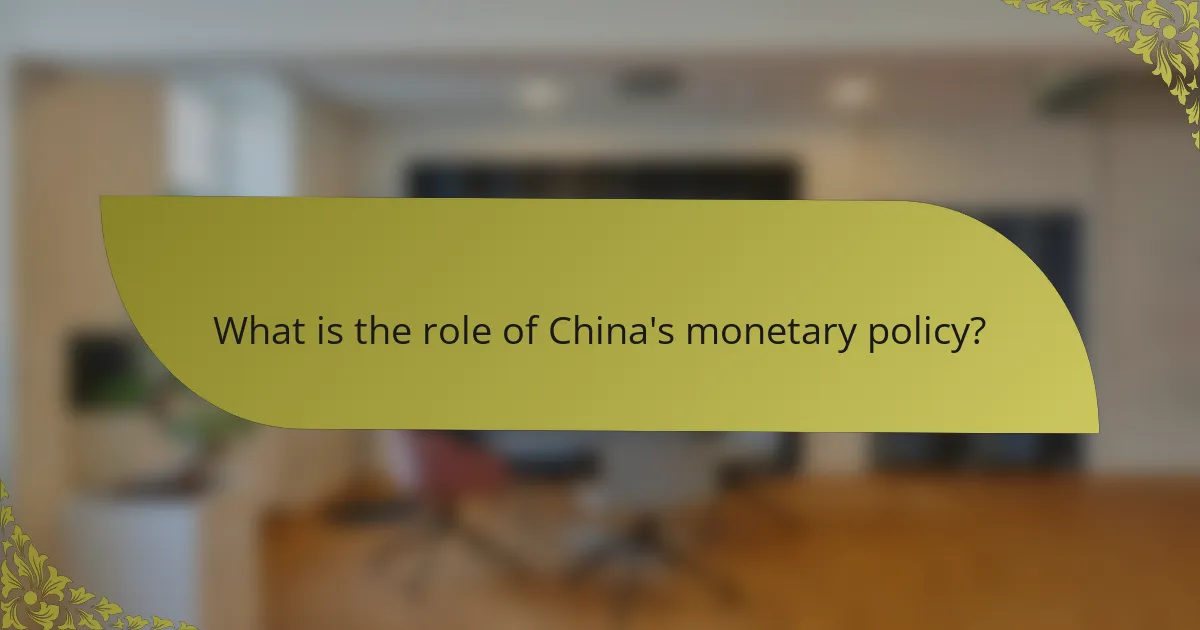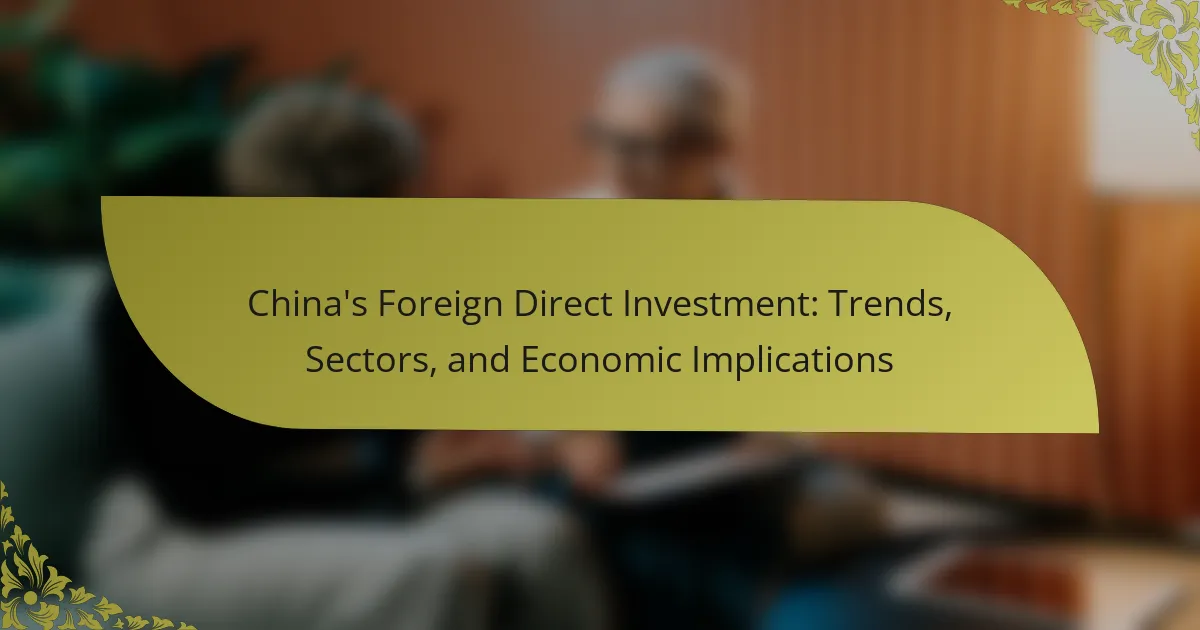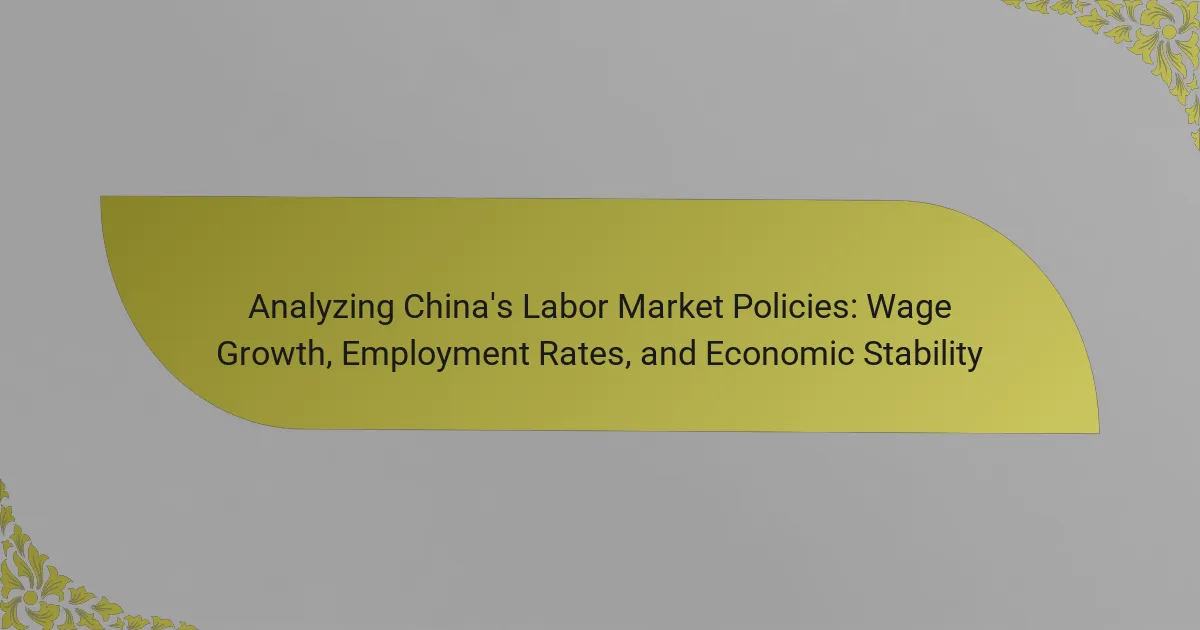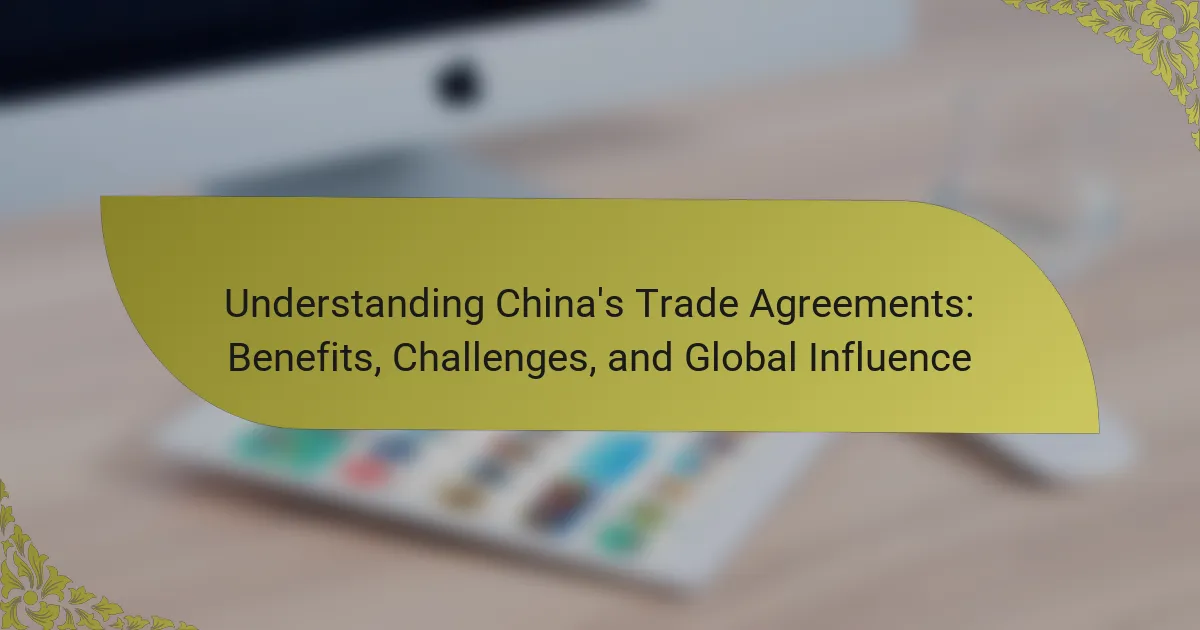China’s monetary policy is a key mechanism for managing the country’s economic landscape, focusing on inflation control, currency stabilization, and economic growth promotion. The People’s Bank of China (PBOC) employs various tools, including interest rate adjustments and reserve requirement ratios, to influence the money supply and credit availability. Lowering interest rates can encourage borrowing and investment, while raising them can help mitigate inflation. Historical evidence indicates that effective monetary policy has significantly contributed to China’s rapid economic development. Recently, the PBOC has prioritized balancing economic growth with financial stability to ensure sustainable progress.

What is the role of China’s monetary policy?
China’s monetary policy plays a crucial role in managing the country’s economy. It aims to control inflation, stabilize currency, and promote economic growth. The People’s Bank of China (PBOC) implements various tools such as interest rate adjustments and reserve requirement ratios. These measures influence money supply and credit availability in the economy. For instance, lowering interest rates can stimulate borrowing and investment. Conversely, raising rates can help curb inflation. Historical data shows that effective monetary policy has contributed to China’s rapid economic development. In recent years, the PBOC has focused on balancing growth with financial stability.
How does China’s monetary policy influence inflation control?
China’s monetary policy influences inflation control primarily through interest rate adjustments and reserve requirements. By adjusting the benchmark interest rates, the People’s Bank of China (PBOC) can either encourage borrowing or discourage it. Lowering interest rates typically stimulates economic activity, increasing demand and potentially raising inflation. Conversely, raising rates can cool down an overheating economy, helping to control inflation.
Additionally, the PBOC sets reserve requirement ratios for banks. Increasing these ratios reduces the money supply available for lending. This action can help to curb inflation by limiting the amount of money circulating in the economy. In 2021, for instance, the PBOC lowered the reserve requirement ratio to support economic growth amid the pandemic, which influenced inflation rates.
Moreover, the PBOC employs open market operations to manage liquidity in the financial system. By buying or selling government bonds, the central bank can influence short-term interest rates and liquidity, thereby impacting inflation. In 2020, these measures were crucial in responding to economic challenges posed by COVID-19.
Overall, China’s monetary policy tools directly affect the money supply and economic activity, which are key determinants of inflation.
What tools does the central bank use for inflation control?
The central bank uses several tools for inflation control. These include interest rate adjustments, open market operations, and reserve requirements. By changing interest rates, the central bank influences borrowing costs and consumer spending. Open market operations involve buying or selling government securities to manage liquidity in the economy. Adjusting reserve requirements affects how much banks can lend, impacting money supply. These tools help maintain price stability. Historical data shows that these methods have been effective in managing inflation rates in various economies.
How effective are these tools in managing inflation rates?
Monetary policy tools in China are effective in managing inflation rates. These tools include interest rate adjustments, reserve requirement ratios, and open market operations. By raising interest rates, the central bank can discourage borrowing. This leads to reduced consumer spending and investment, which helps lower inflation. Conversely, lowering interest rates can stimulate economic activity. However, excessive use of these tools can lead to other economic issues. Historical data shows that in 2011, China raised interest rates multiple times to combat rising inflation, which peaked at 6.5%. The effectiveness of these tools varies based on the economic context. Overall, while these tools can manage inflation, their impact is influenced by external factors and domestic economic conditions.
What is the relationship between China’s monetary policy and interest rates?
China’s monetary policy directly influences interest rates. The People’s Bank of China (PBOC) adjusts interest rates to control inflation and stabilize the economy. When the PBOC lowers interest rates, borrowing becomes cheaper. This encourages spending and investment, stimulating economic growth. Conversely, raising interest rates makes borrowing more expensive. Higher rates can help control inflation by reducing consumer spending. Historical data shows that changes in the PBOC’s benchmark interest rate often align with shifts in monetary policy. For instance, during economic slowdowns, the PBOC typically reduces rates to spur growth. This relationship is crucial for maintaining economic stability in China.
How does the central bank set interest rates in China?
The central bank of China, known as the People’s Bank of China (PBOC), sets interest rates through a combination of tools and policy decisions. The PBOC primarily uses the benchmark interest rates, including the one-year lending and deposit rates, to influence economic activity. Adjustments to these rates are made in response to economic indicators such as inflation and growth rates.
The PBOC also employs open market operations to manage liquidity in the banking system. By buying or selling government bonds, the bank can influence the amount of money circulating in the economy, thereby affecting interest rates indirectly. Additionally, the PBOC may adjust the reserve requirement ratio, which dictates how much banks must hold in reserve and influences their lending capacity.
In recent years, the PBOC has adopted a more market-oriented approach to interest rate setting. This includes allowing greater flexibility in the rates banks can offer to customers. The central bank’s decisions are influenced by both domestic economic conditions and global financial trends.
Overall, the PBOC’s interest rate setting is a dynamic process aimed at balancing inflation control and economic growth.
What impact do interest rate changes have on the economy?
Interest rate changes significantly impact the economy by influencing borrowing costs and consumer spending. When interest rates rise, loans become more expensive. This typically leads to reduced consumer spending and business investment. Consequently, economic growth may slow down. Conversely, when interest rates decrease, borrowing costs lower. This encourages consumer spending and business expansion, potentially stimulating economic growth. Historical data shows that during the 2008 financial crisis, central banks lowered interest rates to boost economic activity. This action aimed to counteract the recession by making credit more accessible. Interest rate changes, therefore, serve as a critical tool for managing economic stability and growth.
How does China’s monetary policy affect economic growth?
China’s monetary policy directly influences economic growth by adjusting interest rates and managing money supply. When the People’s Bank of China lowers interest rates, borrowing becomes cheaper. This encourages investment and consumer spending, which can stimulate economic growth. Conversely, raising interest rates can slow down economic activity by making loans more expensive.
Additionally, China’s monetary policy affects inflation rates. A stable inflation rate can create a favorable environment for economic growth. According to the International Monetary Fund, China’s monetary policy adjustments have historically correlated with GDP growth rates. For instance, during the 2008 global financial crisis, China implemented expansionary monetary policies, resulting in a significant GDP growth rebound.
In summary, China’s monetary policy is a crucial tool for managing economic growth through interest rate adjustments and inflation control.
What are the primary goals of China’s monetary policy regarding growth?
The primary goals of China’s monetary policy regarding growth are to maintain economic stability and promote sustainable growth. This includes managing inflation rates and ensuring adequate liquidity in the financial system. The People’s Bank of China (PBOC) aims to support investments and consumption through interest rate adjustments. By keeping interest rates low, the PBOC encourages borrowing and spending. Additionally, the monetary policy focuses on controlling credit growth to prevent asset bubbles. Historical data shows that these measures have contributed to China’s GDP growth rates averaging around 6-7% in recent years. Overall, China’s monetary policy is designed to balance growth with financial stability.
How does monetary policy interact with fiscal policy to promote growth?
Monetary policy interacts with fiscal policy to promote economic growth by influencing interest rates and overall economic activity. Central banks adjust interest rates through monetary policy to encourage borrowing and spending. Lower interest rates make loans cheaper, stimulating business investments and consumer spending. Fiscal policy complements this by increasing government spending or cutting taxes to boost demand. For example, during economic downturns, coordinated efforts between monetary and fiscal policies can lead to faster recovery. Studies show that countries implementing integrated monetary and fiscal strategies experience more robust growth. In China, this collaboration has been essential in navigating economic fluctuations and sustaining growth rates.
What challenges does China’s monetary policy face in current economic conditions?
China’s monetary policy faces challenges such as slowing economic growth and rising inflation. The economy has been impacted by global supply chain disruptions and domestic demand fluctuations. Inflation rates have increased, reaching levels not seen in years. This complicates the central bank’s goal of maintaining price stability. Additionally, the property market crisis has led to reduced consumer confidence. The People’s Bank of China must balance stimulating growth while controlling inflation. Interest rate adjustments may not be sufficient to address these issues. These challenges require careful policy navigation to ensure economic stability.
How do global economic factors influence China’s monetary policy decisions?
Global economic factors significantly influence China’s monetary policy decisions. These factors include international trade dynamics, foreign investment flows, and global interest rates. For instance, fluctuations in global commodity prices can affect inflation rates in China. When commodity prices rise, it can lead to increased production costs. This, in turn, may prompt the People’s Bank of China to adjust interest rates to manage inflation. Additionally, changes in the U.S. Federal Reserve’s interest rates can impact capital flows into China. A higher U.S. interest rate may lead to capital outflows from China, prompting a response in monetary policy. Furthermore, global economic slowdowns can reduce demand for Chinese exports. This can lead to adjustments in monetary policy to stimulate domestic growth. Overall, China’s monetary policy is closely aligned with global economic trends to maintain stability and growth.
What are the risks associated with China’s current monetary policy approach?
China’s current monetary policy approach carries several risks. One significant risk is inflationary pressure. The People’s Bank of China has implemented low interest rates to stimulate growth. This can lead to excessive borrowing and spending, which may increase inflation rates. Another risk is asset bubbles. Low interest rates can drive investors towards riskier assets, inflating prices in real estate and stock markets. Additionally, there is a risk of currency depreciation. An aggressive monetary policy may weaken the yuan, impacting international trade. Lastly, high levels of debt pose a systemic risk. Increased borrowing can lead to defaults, threatening financial stability. These risks highlight the delicate balance China must maintain in its monetary policy.
How can businesses adapt to changes in China’s monetary policy?
Businesses can adapt to changes in China’s monetary policy by adjusting their financial strategies. They should monitor interest rate fluctuations closely. Changes in rates can impact borrowing costs. Businesses may need to refinance existing debt to take advantage of lower rates.
Additionally, companies should reassess their pricing strategies. Inflation control measures can affect consumer spending. Adjusting prices in response to monetary policy can help maintain profit margins.
Furthermore, businesses should diversify their investments. This can mitigate risks associated with monetary policy shifts. Companies may explore opportunities in sectors less affected by policy changes.
Lastly, maintaining a flexible operational model is crucial. Businesses should be prepared to pivot quickly in response to policy adjustments. This agility can enhance resilience in a fluctuating economic environment.
What strategies can businesses implement to mitigate risks from interest rate changes?
Businesses can implement several strategies to mitigate risks from interest rate changes. One effective strategy is to use interest rate swaps. These financial instruments allow companies to exchange fixed interest rate payments for variable ones, or vice versa. This can help stabilize cash flows against rising rates.
Another strategy is to diversify financing options. By accessing various funding sources, such as loans, bonds, or equity, businesses can reduce reliance on any single interest rate environment. This diversification can help manage exposure to interest rate fluctuations.
Additionally, companies can lock in fixed-rate loans. Securing loans at fixed rates provides predictability in financial planning and shields businesses from future rate hikes. This strategy is particularly useful in a rising interest rate environment.
Implementing a robust cash management strategy is also vital. Maintaining adequate liquidity can help businesses navigate periods of high interest rates by ensuring they can meet obligations without incurring additional debt.
Finally, conducting regular financial analysis and forecasting can aid businesses in anticipating interest rate changes. This proactive approach allows for timely adjustments in financial strategy to minimize potential impacts.
These strategies are supported by historical data showing that businesses employing them have better managed their financial risks during periods of fluctuating interest rates.
How can companies leverage monetary policy trends for growth opportunities?
Companies can leverage monetary policy trends for growth opportunities by aligning their strategies with interest rate changes and inflation forecasts. When central banks lower interest rates, borrowing costs decrease. This encourages companies to invest in expansion or innovation. For instance, lower rates can lead to increased consumer spending, boosting demand for products and services.
Additionally, companies can monitor inflation trends to adjust pricing strategies. If inflation is rising, businesses may increase prices to maintain profit margins. Conversely, in a deflationary environment, they might lower prices to attract customers.
Research from the People’s Bank of China indicates that effective monetary policy can stimulate economic growth. By understanding these trends, companies can make informed decisions on capital allocation, product development, and market entry. This strategic alignment with monetary policy can lead to sustained competitive advantages.
The main entity of this article is China’s monetary policy, which plays a vital role in managing the country’s economy through inflation control, interest rate adjustments, and economic growth promotion. The article explores the tools used by the People’s Bank of China (PBOC), such as interest rate changes and reserve requirements, to influence money supply and stabilize the economy. It also examines the effectiveness of these tools in managing inflation, the relationship between monetary and fiscal policies, and the challenges posed by current economic conditions. Additionally, the article discusses how businesses can adapt to changes in monetary policy and leverage trends for growth opportunities.



